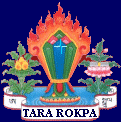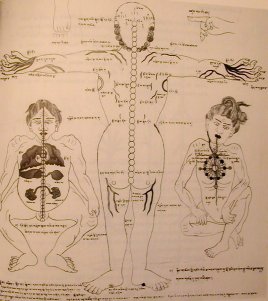| ANATOMY:
THE METAPHOR OF A HOUSE TTM outlines basic anatomy
through an elaborate metaphor of a house, in which each part of the body
is described through a domestic analogy which shows its function and importance.
The stomach, for instance, is compared to the cooking pot of a large inn,
i.e. that which nourishes all other parts, through its important place
in the metabolic chain. The internal organs are compared to a court, in
which there is king, queen, minister etc., each with their own function
but each also working in interdependence to ensure the proper functioning
of the kingdom. Having described the main function of each part of the
anatomy, the medical texts go on to give a rough idea of their relative
volumes and weights.
top of page
CHANNELS This
is one of the most interesting and discussed aspects of TTM and one
must be cautious when reading one or another author's interpretation.
Some very eminent people have made (and continue to make) startling
mistakes concerning this topic. The explanation here is based upon long
discussions held with Prof. Khenpo Tsenam, who is in an exceptional
position to comment being both one of (if not the) finest TTM physicians
and also a most eminent Buddhist scholar.
The channels are an abstract description of physical realities. Let
us take an example. A flowchart on an engineer's wall may show a series
of lines and boxes indicating how raw materials are transformed into
the end product in a factory. Out in the factory itself, there are not
lines and boxes but crushing plants, piles and barrels of faw materials,
boilers, stills, conveyor belts, tubes and a plethora of all sorts of
things. The engineer's flowchart is an abstract simplification of all
that but one which nevertheless enables a skilled person to understand
exactly how slow-downs and faults in one part of the system will have
repercussions elsewhere.
Likewise, the 'channels' are a simplified way of representing the main
processes which keep the body alive. The reality of these processes
is made of nerves, muscles, tissues, blood, bodily fluids, the complex
chemistry in and between organs and so on and so forth. It is particularly
concerned with relating one area of bodily activity to another, to show
their interdependence. These channels are not something other
than the processes. Thus TTM may speak of a channel between the liver
and the eyes. It does not mean that there is some invisible channel
between the two but simply that the one affects the other, through complex
chemical and physical processes. For example, we know these days that
the hypothalamus controls urination through the hormones it secretes
and which are carried circuitously to the top of the kidneys through
the blood stream. There is no direct 'tube' from the hypothalamus to
the kidneys but that is just how TTM might have portrayed it to show
the link between the two and to establish a mechanism. The channels
are a schematic map of bodily relations, not an anatomical chart. This
having been said, many of the main channels do correspond to major vascular,
nervous and endocrine canals of the body, as these are its major highways
of communication.
Not aware of this schematic nature of the channels, there are still
many people these days who take the channels - as they are expressed
in TTM - to be 'psychic channels', since there is no direct physical
counterpart found in the dissected corpse. Others simply and erroneously
equate the channels to branches of the central nervous system. It is
not entirely their fault that such people miss the point when it comes
to TTM. Buddhist practice uses similar stylised maps of the body in
meditation and has developed a system whereby advanced meditation using
them can sufficiently influence the brain to produce useful changes
in the yogin's body. Furthermore, the stylised maps bear a relationship
to the purified, divine body described in vajrayana Buddhism. One should
take great pains not to confuse the medical and meditational systems.
Doctors and meditators alike recommend this. To understand the relationship
between the medcial and meditational channels requires considerable
understanding and experience of meditation, as well as knowledge of
the Buddhist concept of the universe. It needs the intelligence which
can discern what applies to physical reality and what applies to mental
exercise.
The texts describe four main types of channels. These are not four
different types but the same channels discussed from four points of
view, according to their function. They are:
 Generative
channels, which give rise to the body and the three biodynamics Generative
channels, which give rise to the body and the three biodynamics
 Existence
channels, which sustain the body, keep the senses clear, the mind alert
etc. Existence
channels, which sustain the body, keep the senses clear, the mind alert
etc.
 Connecting
channels, which are mainly described through the activities of some
700 blood vessels and 19 main nerves and their ramifications. Connecting
channels, which are mainly described through the activities of some
700 blood vessels and 19 main nerves and their ramifications.
 Life-supporting
channels Life-supporting
channels
Some of these channels are described as critical, inasmuch as their
malfunction can be life-threatening.
top of page
CRITICAL POINTS
These are important points in the body which
are particularly vulnerable and injury to which may lead to grave injury
or death. The texts describe some 302 of them, related to the flesh,
adipose tissue, bones, tendons and ligaments, 'full'
organs (spleen, liver, kidneys, heart and lungs), 'hollow' organs (stomach,
gall bladder, bladder, small intestine and large intestine) and channels.
top of page
PATHWAYS
These are the main pathways through which the body
is sustained. Some are external while others are internal. The internal
ones are primarily concerned with the sevenfold process of metabolism
(more fully described below in physiology) which
at each stage produces both nutrients and wastes. The 9 external
ones common to both sexes are the eyes, ears, nostrils, mouth, urethra
and anus. Women also have the two nipples and the vagina.
top of page
PHYSIOLOGY
THE TARGETS OF PATHOGENIC AGGRESSION Appropriate
diet and sensorial nourishment, efficient digestion and a subsequent
efficient metabolism, along with the correct production and evacuation
of wastes, is central to TTM's notion of what is needed for the maintainence
of good health. The overall metabolic process (described in the next
sections) starts from the intake of nourishment and follows catabolic
and anabolic processes from the intestines through the whole digestive
tract to the liver and on, step by step, to the production of other
bodily tissues up to the final 'glow' of good health. Each stage produces
certain nutrients, required by the body, and certain by-products, which
mainly need to be eliminated. It is evident that anything which goes
wrong in this vital chain is going to have important repercussions on
health. The physician needs to understand these processes intimately
and to know how to use behaviour, diet, medicines or more radical treatments
to correct any disorders that occur.
top of page
METABOLIC FIRE This
topic concerns the production of energy from nutrients. "The "metabolic
fire " is the basis of digestion but is also the energy component present
in the three main biodynamics, in the body constituents and in the excreta.
The texts say:
" It makes one free from sickness, able to be active, and it gives
radiance and glow, longevity, and strengthens the metabolic heat of
the body constituents."
A certain amount of metabolic fire, generated by:
... proper mastication and production of phlegm,
... a proper production of bile and
... proper transit of foodstuffs and the 'wind' biodynamic,
is needed to break food down into what will produce both energy and
vital bodily nutrients. If this initial fire is insufficient, nutrients
will not be properly processed and will either be wasted, eliminated
as excreta, or else they will create harmful residues. Weakness and
depletion, with various sequela, may ensue. Thus a healthy diet -described
as one which is not too heavy and one which is warming by nature
(giving energy to the body rather than taking it from it) - is needed
and this diet should match the person's digestive ability.
An important part of TTM is to ensure that the patient is getting the
maximum energy out of his/her diet and to see that the diet suits his
or her needs and lifestyle. In TTM, good diet and good digestion hold
a prime place in prophylactic medicine as well as being a vital adjunct
to the various therapeutic means employed.
top of page
THE METABOLIC
CHAIN
|
|
quintessence produced
|
by-products/excreta
|
|
1
|
chyle - nutrients from
food
|
excreta - faeces and urine
|
|
2
|
blood
|
bile
|
|
3
|
flesh
|
secretions of 9 orifices
|
|
4
|
fat
|
sweat and sebum
|
|
5
|
bone
|
teeth, nails and hair
|
|
6
|
marrow
|
oiliness of faeces
|
|
7
|
vital fluids (prob.
mainly hormones) responsible for the glow of good health
|
sperm, ova, menstrual
blood
|
top of page
THE ORIGINS OF PATHOGENIC
AGGRESSION TTM looks at pathogenesis on three timescales.
The first harks back to a distant past and is related to the psychology
of the person. Being a Buddhist medicine, this past also includes the
mind and actions of the person in past lives. Be it in this life or
previous ones, the psychological capital of a person is seen as having
an overall influence on their biology. This influence is key in the
generation of the three main biodynamics, which are such an important
topic in TTM that they will not be treated here but on
their own page. Desire and attachment is intimately connected with
the Vata biodynamic. Anger and rejection
is intimately connected with the Pitta
biodynamic and confusion and ignorance intimately related to the Kapha
biodynamic.
On a second timescale, one has the resultant physiology of the person,
with its strengths and weaknessnes and in which the three biodynamics
are the vectors of both health and sickness. When they are functioning
as they ought ('each in their own place') and not 'modified' they bring
good and balanced health. When they fall out of balance through depletion,
excess or conflict, they can harm one or more of the seven stages of
metabolism (or the processes of excretion) and sickness results.
There is a third, very immediate stage of pathogenesis, which concerns
the immediate circumstances which have triggered the malady. To give
an over-simplified example to show this point:
... the person's psychological capital from the past may be highly
characterised by desire
... this causes one of the three biodynamics to outweigh the others
and make for an oversensitive person, quite vulnerable and easily depleted
of energy when they cannot control their environment
... the person being too lightly dressed one day and exposed to harsh
noises and mental stress may crack up suddenly - have a mini breakdown
- much more quickly than someone else would.
top of page
|

